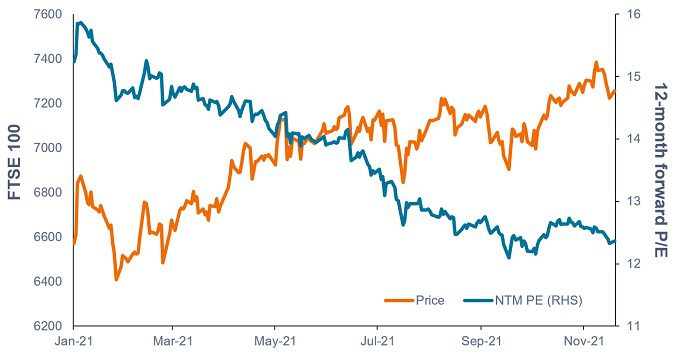UK equities: The boy who cried wolf?

6 minute read
Key takeaways:
- The price paid for an asset is a key determinant of future returns: UK equities appear to be priced at a desirable entry point, by historical standards, and relative to other major global markets.
- Rising yields should favour perceived ‘inflation hedges’ such as financials and commodities, where the UK market has a relatively large allocation.
- Brexit and a difficult journey through COVID for much of 2020 are two obvious culprits for the UK’s relatively weak performance. As Brexit recedes into the past, and the economy continues to recover from the pandemic, these headwinds could easily switch to tailwinds.
I, and many of my colleagues, have opined on numerous occasions that UK equities are undervalued compared to other global markets and therefore represent a potentially attractive investment prospect for the coming years. It is fair to say that we have been ‘early’ (a less charitable appraisal would be ‘wrong’) on this call thus far. While Aesop’s fable about the boy who cried wolf might be a lesson about telling the truth, rather than calling a market too early, he was eventually right, and I still believe our views on UK equities will be too, in predicting that the UK equity market will outperform over the next decade. The question now becomes, how do you convince investors long since habituated to mistrusting such opinions?
The price paid for an asset remains a key determinant of future returns
Exhibit 1 shows a high and consistent correlation between the starting price/earnings ratio (P/E) and performance of the UK equity market. Simply put, the cheaper the market has been in any given year, the higher the return over the following decade.

This argument has become ever more pertinent in 2021, as P/E ratios in the UK market have shifted even lower (Exhibit 2), falling from 15x earnings at the start of the year to slightly above 12x earnings in September, even though the market is healthily up. This is because earnings in the UK have risen much more than share prices. While there are no assurances that history will repeat itself (Exhibit 1 implies a 10-year real return of approximately 9% per annum at these P/E levels), these are objectively attractive entry levels for investors, relative to other developed markets, particularly the US.

This is not just our view. Morgan Stanley produce research each year that models 10-year nominal expected returns based upon regression analysis and prevailing valuation levels. This research predicts that the UK equity market is expected to produce the highest returns across all major global markets, with estimated returns of 10.3% per annum for the MSCI UK Index. This compares to a more modest 5.2% expected from the S&P 500 Index, reflecting the scale of the premium for US equities relative to the UK (Exhibit 3).

The argument for UK equities is not just price
There are also fundamental structural arguments behind why we expect the UK equity market to perform better from here. The UK market is more heavily weighted towards parts of the market perceived as ‘value’ (such as commodities and financials) than the US, while being underweight growth sectors, like technology. This has been a drag on UK equity market performance for many years. But we believe that this could all be changing. While we do not expect current high inflation levels to persist, we do expect inflation to settle at a higher mark than we have grown used to over the past decade. We see the era of disinflation as behind us, hence our view that the trend of ever-lower bond yields has ended too. If this is true, then the environment no longer supports growth sectors over value ones. As the discount rate goes up, the low yields on longer-duration growth sectors (ie. those stocks where earnings are anticipated to be high further in the future) look less attractive, while rising yields usually favour perceived ‘inflation hedges’… such as financials and commodities.
The Janus Henderson Cautious Managed Fund is predominantly a UK portfolio. In recent years this has been a significant headwind against our IA Mixed Investment 20-60% Shares peer group, which is, in the main, much more globally orientated. Irrespective of stock selection, these peers have often benefited from both stronger relative equity market returns and the appreciation of overseas currencies against sterling. Brexit and our COVID experience are two obvious culprits for the UK’s relatively weak performance. But as Brexit steadily recedes into the past, and we adapt to, and see better treatments to deal with COVID, these headwinds could easily switch to tailwinds.
—–
Glossary:
Bond yield: The level of income on a security, typically expressed as a percentage rate. For a bond, this is calculated as the coupon payment divided by the current bond price.
Disinflation: A fall in the rate of inflation.
Growth investing: Growth investors search for companies they believe have strong growth potential. Their earnings are expected to grow at an above-average rate compared to the rest of the market, and therefore there is an expectation that their share prices will increase in value.
Inflation hedge: An asset or investment that is expected to maintain or increase in value relative to the level of inflation over time.
Nominal/Real return: ‘Real return’ is the return on an investment after taxes and inflation. ‘Nominal return’ includes taxes and inflation.
Price/earnings (P/E) ratio: A popular ratio used to value a company’s shares, compared to other stocks, or a benchmark, such as the FTSE All-Share Index. It is calculated by dividing the current share price by its earnings per share.
Regression analysis: A statistical process for estimating the relationship between different variables, quite often over time.
Value investing: Value investors search for companies that they believe are undervalued by the market, and therefore expect their share price to increase. One of the favoured techniques is to buy companies with low price to earnings (P/E) ratios.
Yield: The level of income on a security, typically expressed as a percentage rate. For equities, a common measure is the dividend yield, which divides recent dividend payments for each share by the share price. Expensive stocks will therefore often have a lower yield, reflecting their higher price. For a bond, this is calculated as the coupon payment divided by the current bond price.
These are the views of the author at the time of publication and may differ from the views of other individuals/teams at Janus Henderson Investors. References made to individual securities do not constitute a recommendation to buy, sell or hold any security, investment strategy or market sector, and should not be assumed to be profitable. Janus Henderson Investors, its affiliated advisor, or its employees, may have a position in the securities mentioned.
Past performance does not predict future returns. The value of an investment and the income from it can fall as well as rise and you may not get back the amount originally invested.
The information in this article does not qualify as an investment recommendation.
Marketing Communication.
Important information
Please read the following important information regarding funds related to this article.
- Shares/Units can lose value rapidly, and typically involve higher risks than bonds or money market instruments. The value of your investment may fall as a result.
- An issuer of a bond (or money market instrument) may become unable or unwilling to pay interest or repay capital to the Fund. If this happens or the market perceives this may happen, the value of the bond will fall.
- When interest rates rise (or fall), the prices of different securities will be affected differently. In particular, bond values generally fall when interest rates rise (or are expected to rise). This risk is typically greater the longer the maturity of a bond investment.
- If a Fund has a high exposure to a particular country or geographical region it carries a higher level of risk than a Fund which is more broadly diversified.
- The Fund may use derivatives with the aim of reducing risk or managing the portfolio more efficiently. However this introduces other risks, in particular, that a derivative counterparty may not meet its contractual obligations.
- When the Fund, or a share/unit class, seeks to mitigate exchange rate movements of a currency relative to the base currency (hedge), the hedging strategy itself may positively or negatively impact the value of the Fund due to differences in short-term interest rates between the currencies.
- Securities within the Fund could become hard to value or to sell at a desired time and price, especially in extreme market conditions when asset prices may be falling, increasing the risk of investment losses.
- Some or all of the ongoing charges may be taken from capital, which may erode capital or reduce potential for capital growth.
- The Fund could lose money if a counterparty with which the Fund trades becomes unwilling or unable to meet its obligations, or as a result of failure or delay in operational processes or the failure of a third party provider.
- In respect of the equities portfolio within the Fund, this follows a value investment style that creates a bias towards certain types of companies. This may result in the Fund significantly underperforming or outperforming the wider market.
